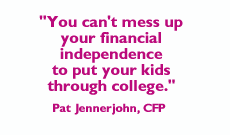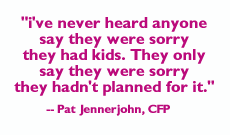|
The cost of having kids late
|
 |
April 17, 2000: 9:20 a.m. ET
You've waited a long time for a family, but are your long-term savings ready?
By Staff Writer Jeanne Sahadi
|
NEW YORK (CNNfn) - Your 20s have flown by, and you're about to bid your 30s adieu. Until this point, you and your spouse have been devoted to your careers, or at least to your freedom. But now you're eager for something more -- like 3 a.m. feedings, Tinky Winky, and heart-wrenching pleas for puppies and ice cream.
That means it's time to take a hard look at your finances and do more than hope everything will be OK when your baby's in college and you're a heartbeat away from retirement.
Rebalance the balance sheet
Of course, there can be financial advantages to having kids late. You've had a number of years to save for retirement, and your child is joining you in your peak earning years.
 You'll also be in a strong position if you own your home and don't have credit card debt. You'll also be in a strong position if you own your home and don't have credit card debt.
But that's a lot of variables for many people, and if you haven't maximized your savings opportunities before starting a family, at the very least you might readjust your expectations about when you can retire, said certified financial planner (CFP) Pat Jennerjohn.
It's impossible to place a benchmark on just how much the average person should have saved before having kids in midlife. But Jennerjohn suggested that for spouses between 38 and 40, ideally each might have about $250,000 in a tax-deferred vehicle. If not, she said, "Don't plan to retire at 55."
Keep those contributions coming
If that $250,000 seems high, in part that's because Jennerjohn is figuring you might reduce your retirement contributions once you have children, like many people do.
After all, you're going to need more cash flow -- at a bare minimum, you will pay between $5,200 and $10,000 a year for your child's clothes, food, toys, birthday parties, and a lesson or two. Figure considerably more if you want to send him or her to day care, private school, or summer camp, financial planners said.
 But whatever you do, don't go cold turkey on the 401(k) contributions for the next 20 years, thinking you'll make up ground in your late 50s. You won't, and as a result you could find yourself hard up for retirement funds just when the "empty nest syndrome" sets in. But whatever you do, don't go cold turkey on the 401(k) contributions for the next 20 years, thinking you'll make up ground in your late 50s. You won't, and as a result you could find yourself hard up for retirement funds just when the "empty nest syndrome" sets in.
This is especially true if you haven't saved much at all before your child was born. If that's your predicament, you certainly can plan on one thing: "Everything's going to hit the fan at once," CFP Karen Altfest said.
With college and retirement coming at roughly the same time, not to mention the possibility of caring for an ailing parent, the burden of saving and paying for everything simultaneously is quite heavy.
Altfest said if you start saving in your 20s and do so consistently throughout your career, putting aside 10 percent of your salary should work fairly well. But if you wait until your 50s, you'll have to put away fully half of your income, and that's nearly impossible for most people.
"It's very scary," she said.
The education consideration
Let's face it: You take this parental responsibility thing seriously and you know it's going to cost you, but you don't want it to cost your kids. The last thing you want to do is send your children into the world with $100,000 in school loans. You'd rather pay for their college tuition out of pocket or borrow against your retirement money to give them a worry-free education.
Do so at your peril, experts warn.
"You can't mess up your financial independence to put your kids through college," CFP Patricia Jennerjohn said. "If you hit a snag, you don't have as many years to recover."
That's what a client of CFP Marc Freedman is learning the hard way. An employee of a Fortune 500 company, he took a loan against his 401(k) to pay for his kids' college tuition. At 55, he figured he'd have another 10 years to pay it back. He figured wrong.
Stricken by a heart attack, he doesn't know if he'll be able to return to work and is now living on disability payments, which will end when he turns 65. If he can't pay back the $60,000 he borrowed, he will owe income taxes on it if and when his employment is terminated.
Inheritance helps
Of course, one way to protect your long-term savings from the ravages of educational expense is inheritance.
 "The money you inherit will come to you tax-free. Let that money be the money that funds education costs," Freedman said. "The money you inherit will come to you tax-free. Let that money be the money that funds education costs," Freedman said.
But what if you're not in line for an inheritance, or at least not enough to cover four years of college? "The kids might have to pay for it on their own," CFP Judi Martindale said.
Or they might choose a state school, Freedman suggested. After all, he added, "You can't go to charity to support your retirement."
You're not in it for the money
But you also can't go to your retirement account for the kind of love and satisfaction you get when your five-year-old runs to show you what she made in art today.
"If you look at having children as a purely financial decision, we'd have zero-population growth real fast," Jennerjohn said.
So your retirement savings probably won't be a determining factor in whether you have a family or not. And it shouldn't be. The rewards of children can be too great, and the decision to have them in your late 30s or early 40s is usually a more considered one than if you had them back in the days when age 50 seemed like the horizon -- far off.
Still, retirement is not an issue that should be put on the back burner when budgeting for your new family.
"I've never heard anyone say they were sorry they had kids. They only say they were sorry they hadn't planned for it," Jennerjohn said. 
|
|
|
|
|
 |

|

